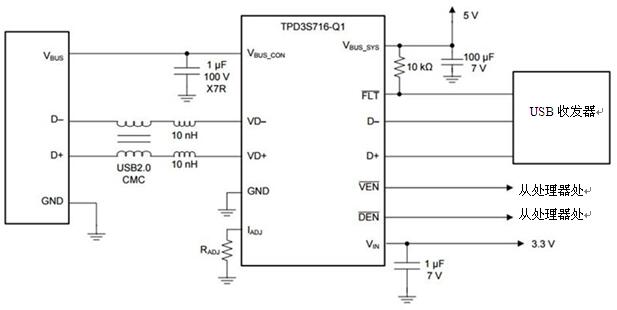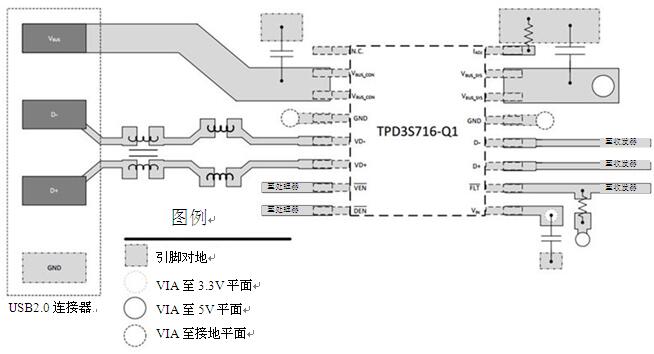As the Type C USB connector becomes the new standard in the consumer space, USB is entering more solutions such as automotive infotainment systems. When designing the highest reliability, the USB port expansion in different locations in the car presents a unique challenge. Because of faults such as battery short-circuit, short-circuit, and electrostatic discharge (ESD) conditions, automotive USB applications present use cases that do not exist in other markets. As power flows through the host vehicle battery, they are affected by the high voltage and current spikes that occur during the intended operation. In addition, connecting the processor, USB hub, charge controller, and load switch to the downstream circuitry on the VBUS and data lines requires protection against battery short-circuit events.
This article refers to the address: http://
In order to prevent the USB battery from being short-circuited, the overvoltage protection circuit must be used to disconnect the system power when the voltage at the USB interface is above the overvoltage threshold. Overvoltage field-effect transistors (FETs) should have fast response times to disconnect system power as quickly as possible, protecting the upstream system-on-chip (SoC) from unwanted voltage and current spikes. In addition, the USB 2.0 specification requires the use of an overcurrent detection circuit to automatically limit the current in an overcurrent event. Internal switches prevent excess battery damage to upstream equipment, maintain 5V rail stability, and properly isolate faults.
In Part 1 of the two-part series; I explained the best way to protect the USB circuit from a short-circuit in the battery. In this blog post, I will extend the best way to optimize your car's USB battery short-circuit design.
As automotive manufacturers may change overall output current requirements throughout the project, protection solutions with adjustable current limiting provide system designers with more flexibility; allowing them to easily adjust the output current of the USB port without restrictions A new device. If you need to protect your sensitive electronics from battery shorts and support up to 2.4A, you may need a flexible battery-proof short-circuit chip.
The TPD3S716-Q1 can charge for USB battery charging 1.2 (BC1.2), C-type USB 5V / 1.5 A and dedicated up to 2.4A charging peripherals. The automotive USB 2.0 interface protector is a single-chip solution with battery short-circuit, short-circuit and ESD protection with an adjustable current-limit load switch. The current threshold for overcurrent protection can be adjusted by a ground (GND) external resistor RADJ on the IADJ pin, as shown in Figure 1.

Figure 1: Typical application configuration for the TPD3S716-Q1
USB One-Click Copy (OTG) is another specification commonly used in automotive environments because it allows USB devices to switch between host and client roles. This feature is critical for USB high-speed applications where the head unit must be an extension of the mobile media experience. In order to achieve this goal, the head unit must be able to work in USB device mode accordingly.
The TPD3S716-Q1 has two enable inputs that can turn the internal FET of the device on/off. The VEN pin disables and enables the VBUS path, while the DEN pin disables and enables the data path. Independent control of VBUS and data paths allows you to configure this device for USB host and client/OTG mode, as shown in Table 1.

Table 1: Table of normal operation modes of equipment for TPD3S716-Q1
The easy access and small footprint to match the size range of the USB connector is an important consideration in USB high-speed protection solutions designed to facilitate layout and maintain signal integrity. The flow-through pin mapping allows the signal path to pass through the package, as shown in Figure 2.

Figure 2: Example of a typical layout of the TPD3S716-Q1
Designed to prevent shorting of the USB battery, consider using a solution with adjustable current limit, OTG/client mode, and flow through routing. Doing so allows you to use additional features that are not currently present in other anti-battery short-circuit solutions.
other information
· Read my other blog posts on how to protect your car's USB from battery shorts.
• View a two-port automotive USB 2.0 hub reference design with battery short-circuit protection.
· Read the white paper, "Designing USB with battery short-circuit tolerance in an automotive environment."
· Evaluate your car's USB 2.0 battery short-circuit protection design with the TPD3S714-Q1 evaluation module.
The FirstPower Long life battery is desgined for apllcation as General Purpose and long life. The series focus on improving trickle life that base on Standard series.
We welcome orders with "FirstPower" brand; We are also flexible to accept orders on OEM basis. Contact us now! Your partnership with FirstPower will prove worthy of it.
Long Life Battery,Gps Tracker Long Life Battery,Long Life Electric Scooter Battery
Firstpower Tech. Co., Ltd. , https://www.firstpowersales.com